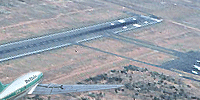 |
 |
|
||||
|
By
Wikipedia,
The Stearman (Boeing) Model 75 is a biplane, of which at least 9,783 were built in the United States during the 1930s and 1940s as a military trainer aircraft. Stearman became a subsidiary of Boeing in 1934. Widely known as the Stearman, Boeing Stearman or Kaydet, it served as a Primary trainer for the USAAF, as a basic trainer for the USN (as the NS & N2S), and with the RCAF as the Kaydet throughout World War II. After the conflict was over, thousands of surplus aircraft were sold on the civil market. In the immediate post-war years they became popular as crop dusters and as sports planes. Design
The Kaydet was a conventional biplane of rugged construction with large, fixed tailwheel undercarriage, and accommodation for the student and instructor in open cockpits in tandem. The radial engine was usually uncowled, although some Stearman operators choose to cowl the engine, most notably the Red Baron Stearman Squadron. VariantsThe US Army Air Forces Kaydet had three different designations based on its power plant:
The US Navy had several versions including:
OperatorsPost-War UsageAfter World War II, the thousands of PT-17 Stearmans were auctioned off to civilians and former pilots. Many were modified for cropdusting use, with a hopper for pesticide or fertilizer fitted in place of the front cockpit. Additional equipment included pumps, spray bars, and nozzles mounted below the lower wings. A popular approved modification to increase the maximum takeoff weight and climb performance involved fitting a larger Pratt & Whitney R-985 engine and a constant speed propeller. SurvivorsA considerable number of Stearmans remain in flying condition throughout the world, as the type remains a popular sport plane and warbird.
Specifications (PT-17)Data from {name of first source} General characteristics
Performance
See alsoComparable aircraft BibliographyVideographyExternal links
Text from Wikipedia is available under the Creative Commons Attribution/Share-Alike License; additional terms may apply.
Published in July 2009. Click here to read more articles related to aviation and space!
|
||||||||||||||||||||||||||||||||||||||||||||||||||

 |
|
Copyright 2004-2025 © by Airports-Worldwide.com, Vyshenskoho st. 36, Lviv 79010, Ukraine Legal Disclaimer |